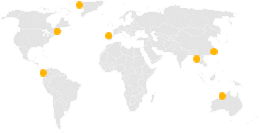Bead stitch is a relatively complicated single-thread chain stitch, which belongs to 104 stitches according to the classification of stitches. Such stitches appear in both positive and negative directions. If you don't have a well-sewn fabric, you only need to sew in the positive direction, and the entire stitch will be easily sewn; the reverse direction will not move, and the more you pull it, the tighter it will be. Therefore, each time the finished fabric needs to leave more no-load stitches at the needle outlet, and the material to be washed needs to be longer to prevent the stitches from being pulled out.
The bead stitch is a single-needle chain stitch formed by organically and closely matching the upper two stitches and the lower two stitches. The stitch formation is as follows:
1. The needle takes the suture through the fabric, drops to the bottom dead center and then rises. At this time, the stitch of the needle cannot rise randomly under the resistance of the presser foot and the fabric, so the first thread of the needle is formed. ring. like:
2. At this time, the hook thread looper moves from the front to the back of the needle, and the prong of the hook thread looper fork passes through the half of the arc groove on the needle and crosses the needle thread loop. The gap between the hook thread looper and the machine needle is 0-0.5mm. When sewing thin materials, the gap is best to be zero. The height of the hook thread looper installed on the hook thread looper crank is 2-2.5mm. This position is ideal and suitable for thread loops formed by various fabrics and unloaded thread loops.
3. When the thread loop of the machine needle reaches saturation, the hook thread looper passes through the loop of the machine needle instantaneously, and the thread loop is crossed with the prong tip of the looper needle and moves toward the straight hook to make the original thread loop. Expand, while making the loop form a strong triangle. ,
4. After the machine needle and the hook thread looper straighten the thread loop into a triangle, the push thread looper moving from right to left will push the hypotenuse line of the triangle loop into between the machine needle and the straight crochet needle in a timely manner.
The rising straight crochet needle is surrounded by a thread loop that is pushed obliquely by 90°, which surrounds the tension and angle of the thread loop before and after it is mainly determined by where the thread loop is sent by the push thread looper: the thread loop is sent far, The thread is tight. The thread of the straight crochet hook loop can be said to be hooked, but it is easy to make the push-thread looper work slowly when it retreats, and the bounce from the bottom of the needle plate will slow down, which will make the loop’s beaded thread If you don’t get it well, the pearl-like upper thread stitch cannot be formed well; if the thread loops are sent too close, the thread loop will be stretched back and loosened by the thread looper if the thread loops are sent too close. When the straight crochet hook is used to hook the loose thread loops When it is time, it is easy to miss stitches. Therefore, the early and late of the thread-pushing loop of the thread-pushing looper, and the speed or slowness of the recovery action directly determine the quality of the loop formation and whether the straight crochet can hang the thread.
5. The machine needle and straight crochet needle rise synchronously. At this time, the straight crochet needle pulls the hooked suture from the needle plate, fabric and presser foot. Machine needles and straight crochet needles rise to the top dead center and begin to descend, and the feeding teeth of the bead edge machine send the fabric out of the first stitch. When the needle bar is lowered, the thread loop drawn from the fabric by the straight hook will form another thread loop on the top of the fabric, and the needle will be inserted into this loop when it is lowered.
Note: The thread loop drawn by the straight crochet hook can only be loosened after the needle is inserted and firmly inserted; if the needle is not inserted properly, the thread loop will be loosened, and the needle will not easily be inserted into the soft The bottom bead line jumps in the loop. When the straight crochet hook is inserted into the fabric, the thread loop is relaxed. The straight crochet hook inserted into the fabric hooks the soft thread loop and will be blocked by the fabric. The thread loop pops out from the hook of the straight crochet hook and is locked above the needle.
6. The needle is hung with the first chain thread and the thread loop drops to the bottom dead center and then rises again. The thread of the needle forms a thread loop again, and the hook thread looper hooks the thread again. Repeated work forms a perfect pearl type. Chain stitches.




 中文
中文 EN
EN

 Building 4, No. 81, Qingyin Lane, Jiulonghu Town, Zhenhai District, Ningbo, Zhejiang
Building 4, No. 81, Qingyin Lane, Jiulonghu Town, Zhenhai District, Ningbo, Zhejiang 86-0574-86533378
86-0574-86533378 86-15372692818
86-15372692818 908197098@qq.com
908197098@qq.com